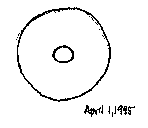
Galileo never mentions observations of Mars in Siderius Nuncius, but he does use observations of the distance Mars gets from Earth to support his claim that the planets revolve around a fixed point which is not the earth. Before Galileo, astronomers had noted a difference in the brightness of Mars over a two year period. These differences were attributed to differences in distance. The telescope improved upon these observations, showing a distance from the earth of 6-8 arcminutes at the closest approach to earth and 25 arcminutes at the maximum distance. Galileo thus states that the planet is close to four times bigger at certain points of its orbit than at others (The Galileo Affair, 61). Galileo also discusses the retrograde motion of Mars, attributing the rare retrogressions to its quicker orbit compared to Jupiter and other planets with more pronounced retrogressions. The earth, in Galileo's mind, is spending more time catching up with Mars and so the retrogression is less (Dialogue, 344).
These differences in distance were undetectable without the telescope. Thus few, if any, people knew the nature of the planet's orbit before Galileo.
An interesting piece of information regarding the consideration of Mars during Galileo's time involves guesswork on the number of moons ot has. Kepler became aware of an anagram Galileo had written about the rings of Saturn. Knowing that Galileo's previous discoveries had been Jupiter's moons, assumed that the message was about Mars' moons. Kepler thus stated that Mars had two moons, an assertion which was later proven true.
Our Observations
The observation of Mars through our weak Galilean telescopes yielded a bright disk, just as Galileo described in Siderius Nuncius (15). The planet was a simple disk, without marks. The observations was made April 1 at about 10:15 pm and shows the planet in the telescope's field of view.

Galileo measured the apparent size of Mars at different points of its orbit in order to determine that the planet appeared larger at some points. Yet due to time and weather restraints, this was not a possible experiment to undertake in our project.
Problems with the observations of Mars
The problem which plagued all observations also affected the Mars data. Houston spring weather (known as "Monsoon Season" by the locals) does not provide much in the way of clear evenings. The other problem involved the weakness of the telescope. This problem prevented better data than that the planet was seen as a bright disk.
Suggestions for further experiment
Galileo determined the distance of Mars at different points in its orbit. Perhaps a next step in the project would be to use the Galilean telescopes for these measurements. Research into Galileo's techniques for measuring heavenly distances would be a good starting point, followed by observations.














 We appreciate any comments or suggestions.
We appreciate any comments or suggestions.